Tattoo touch-ups are a common aspect of the tattooed community, yet many neglect this crucial part of maintaining their artworks.
It’s a question many ponder: “can you get a tattoo touched up after 2 weeks?” The answer sheds light on how tattoos fade and heal over time, and why sometimes, waiting might not be the right thing to do.
Reputable studios and experienced artists emphasize that the benefit of a timely touch-up can elevate your piece, adding intricate linework, shading, and defining key features that might lift from the skin or become dull during the healing process.
It breathes new life into the ink, making everything you need to know about aftercare and cream application all the more essential.
In the ensuing sections, we’ll explore what you need to know about getting your tattoo touched up and how it can benefit your skin art in the long run.
Also Read: How Long To Leave Tegaderm On Tattoos
Why Touch Ups Might Be Necessary?
In the realm of body art, touch ups are a pivotal aspect of maintaining the vibrancy and clarity of a tattoo.
Various reasons necessitate this procedure, including the common changes our skin undergoes as we age, lose or gain weight.
Such transformations can stretch or compact the skin, thereby impacting the tattoo’s look.
It may appear stretched if you’ve gained weight or tighter and out of place if you’ve lost weight, prompting the need to restore its original appearance.
As tattoos age, they naturally fade, with lighter colors like white and yellow losing their sharpness first.
This fade is partly due to exposure to sunlight; hence, care to avoid exposing tattoos to the sun is crucial from the first day.
Moreover, older, outdated techniques and materials, including the ink used, can lead to a faster degradation of the design.
In some cases, individuals might experience allergic reactions or other skin problems due to the ink, which necessitates a retouch to use different materials or methods.
It’s essential to consult a professional to assess whether it’s safe to proceed with a retouch, especially if the tattoo is still healing.
Given my experience in the tattoo industry, I’ve seen firsthand how a well-timed touch-up can breathe new life into a piece that has lost its luster.
However, it’s generally advised to wait until the tattoo has fully healed before considering a touch-up. This process can vary from person to person but typically takes longer than 2 weeks.
Immediate concerns post-tattoo, such as skin reactions, should be addressed promptly with your artist or a dermatologist.
Also Read: What Are The Long Term Effects Of Tattooing Your Body
When Does A Tattoo Need A Touch-Up?
Anyone with a tattoo might require a touch-up over its lifespan. The nature of skin—how it can stretch, sag, and change—means even a perfectly healed tattoo can show imperfections that need fixed with extra ink-work.
It’s not about going over the existing art to make it bold and give a fresh look all over again. All tattoos show signs over time that indicate they could use a little extra care.
Wait until after the initial healing stages before contacting your artist if you notice faded colour, patchy variations, or the boldness of lines isn’t as defined as you’d like.
How To Tell If Your Tattoo Needs A Touch-Up?
When pondering if your tattoo needs rejuvenation, certain signs can indicate the necessity.
Over the lifespan of a tattoo, changes in skin elasticity, such as stretch and sag, can affect its appearance.
As it heals, you might notice imperfections that weren’t apparent initially. Ink-work that once looked bold and fresh may start to look less vibrant. Here’s what to look for:
- Faded colour and patchy variations suggest the ink hasn’t settled uniformly or has started to fade.
- A lack of boldness in lines that were once defined implies it’s time to refresh the design.
- Existing art that seems to simply sag or stretch with your skin indicates a need to revisit your artist.
- If the initial stages of healing reveal a tattoo that looks anything less than perfect, it might require another pass to fix these imperfections again.
Remember, tattoos are as dynamic as the skin they live on. Contacting your artist about touch-ups is a common step in ensuring your body art remains as impactful as the day it was inked.
Also Read: How To Use Tattoo Transfer Paper Without Machine
How Touch Ups Are Done?
The process of a touch-up is similar to getting your original tattoo. The artist starts by cleaning the area, then tracing over the existing design.
New ink is used to add missing lines or shading, ensuring it matches the original hues to refresh the color and make it more vibrant.
While some touch-ups might only address small areas, more extensive changes could require a longer session or multiple sessions for optimal results.

Can You Get A Tattoo Touched Up After 2 Weeks?
It’s crucial to wait until your initial tattoo has healed before considering touch-up work, as the skin is essentially an open wound immediately after being freshly applied.
The typical time for a tattoo to heal ranges from two to four weeks, but this can differ from person to person.
Before proceeding, your tattoo artist will need to examine the tattoo to assess the recovery period.
Although touch-ups might be required, it’s recommended they be performed between one to six months after getting your first tattoo, to ensure optimal healing.
In fact, many artists advise waiting until the first six months are over. At the end of the day, it’s essential to speak with an expert for tailored recommendations on when a retouch is possible, possibly extending up to a year.
Also Read: How Much Does A Tattoo Hurt
Can You Get A Tattoo Touched Up After 3 Weeks?
If you’re wondering whether a tattoo can be touched up after 3 weeks, the answer is generally yes.
In most cases, it’s fine to wait a few weeks for a touch-up to allow the skin to heal properly and the ink to settle into the skin.
However, if there are concerns, it’s crucial to consult with your artist to assess whether a touch-up is necessary and to advise on the best course of action and guidance.
Can You Touch Up A Tattoo The Next Day?
It is not allowed to touch or adjust a tattoo the next day after it’s finished. Just like an open wound, such as a cut or scrape, a fresh tattoo needs care and must be operated with caution.
It’s initially covered with cling wrap or a bandage to protect it. On the first day and night, wearing loose clothing is crucial, and you should stay away from the temptation to remove the bandage or saran wrap prematurely.
Any feelings of redness, warmth, burning, seeping, or swelling are responses from your body to the healing process, highlighting the importance to avoid any actions that might lead to infection.
Keep the area clean with a mild detergent, pat it dry, and allow it to air dry or air out naturally before it’s rewrapped, if necessary.
Can You Touch Up A Tattoo After A Week?
After a week, you should carefully follow the aftercare instructions provided to adjust to the healing of your tattoo.
If you experience discomfort, it’s typically due to the healing process, marked by itching, flaking, and scabbing—inhibiting the possibility of immediate touch-ups.
These signs are normal; however, you must avoid picking, scratching, or peeling at the tattoo, as these actions can cause the healing process to extend longer and increase the risk of destroying the ink.
During the first week, it is advised to wash the tattooed area frequently and moisturize it, ideally limiting this to twice a day, to support the healing.
Also Read: How Long Does Laser Tattoo Removal Take
How Often May A Tattoo Be Touched Up?
Tattoo touch-ups should ideally be scheduled between four weeks and six months after the initial application to allow the skin to properly heal.
This timeframe prevents the ink from becoming muddled or the design turning unattractive.
A touch-up, much like the initial tattoo, undergoes a healing process and must be touched with the same treatment and care to maintain the appearance of the original artwork.
Whether it’s for a minor adjustment or a complete redesign, following the artist’s aftercare instructions ensures the tattoo heals appropriately.
An initial year consultation might be recommended to check and fix any flaws that have become visible post-healing.
While there may not be an extra cost for the initial touch-up, additional touch-ups become optional, especially several years later, for checking fading, discoloration, or defects.
This general procedure is excellent for those contemplating how to improve the quality and appearance of their tattoo’s ink and ensure it remains a visible and attractive piece of artwork.
Tips To Avoid Tattoo Fading
Maintaining your tattoo and design with proper aftercare is a long-term commitment to keep the ink fresh and luminous.
- Water-Based Moisturizers: Utilize special body lotions to prevent your tattoo from fading. Petroleum-based chemicals can harm tattooed skin, while a water-based moisturizer or lotion keeps it moist without damage, as reported by the AAD.
- Avoid Tanners And Sun: Tanning beds and UV rays can lighten tattoo ink and pose a danger of skin cancer. The American Academy of Dermatology warns that ink may react to UV radiation, causing a severe skin reaction.
- Tattoo Placement: Choose a location less exposed to sunlight; fingers and wrists often fade faster due to hand washing and sun exposure. Opt for areas typically covered by clothing to necessitate fewer touch-ups.
- SPF Care: Protecting your tattoo from the sun is crucial. Applying a broad-spectrum, water-resistant sunscreen on exposed areas can prevent the ink from degrading.
- Schedule Touch-Ups: Maintain the clarity and quality of your tattoo by having the ink redistributed in the dermis According to the NCBI, touch-ups can refresh the design, repaint faded areas, and keep your tattoo looking its best.
Also Read: Can You Use Vaseline To Transfer Tattoo Stencil
Why You Shouldn’t Touch Your Tattoo Up Too Soon?
Taking the plunge and getting a tattoo you’ve dreamt of for years is an exciting moment. Congrats! However, the journey doesn’t end there.
The hard part, waiting for it to heal, begins. Temptation to pick at your new ink can be real, but you must resist the urge to touch it up too soon.
1. The Healing Process Is Not Complete
While your tattoo might look healed on the surface level, the layers underneath are still in the process.
Picking at your tattoo prematurely can cause the deeper layers to become infected, leading to problems and trouble. It’s best to leave it alone.
2. The Settling Spectrum Of Ink
Initially, your tattoo’s color might not look perfect. This is because the ink is still settling into your skin from sitting on top.
Over time, it will become more vibrant and clear. Tampering with it before it has a chance to settle could make the outcome worse.
3. Design Integrity At Risk
Picking at your healing tattoo poses a risk of damaging the design. It can distort lines and ruin the overall design, turning your artwork into a big mess.
Be careful, give your tattoo time to heal, and avoid starting any trouble.
4. Aesthetic And Hygiene Concerns
Let’s face it; a scabbing tattoo is plain gross. Nobody wants to see that, and it’s simple common courtesy to do everyone around you a favor and leave the scabby tattoo to heal on its own accord.
A tattoo is supposed to be beautiful, don’t ruin it by picking at it before it’s fully healed.
How Long Does A Tattoo Touch-Up Take To Heal?
Tattoo touch-ups generally require a healing time similar to initial tattoos, ranging from 4 weeks to 6 months, depending on whether it’s a minimal touch-up or a full remodel.
The healing protocol should not aggravate or implicate the artwork, with aftercare measures advised by your artist to ensure it heals in the best possible manner.
A couple of weeks to a month may suffice for smaller touch-ups to heal quicker, but larger or more affected areas can take full time — weeks or even months.
The space of the skin and line or dot work style of the ink also play a significant role in recovery time.
Also Read: How Long Till A Red Ink Tattoo Fades

How Many Times Can You Touch Up A Tattoo?
An initial tattoo appointment often includes a discussion where artists advise clients they may return for a touch-up within the first year to check and correct any imperfections that arise during the healing process, typically as a complimentary service.
Beyond this period, touch-ups are required less frequently, with many opting to check their tattoos every few years for fading, discolouration, or other obvious signs that the art’s quality or the ink’s integrity might be diminishing.
Can You Prevent A Tattoo Touch-Up?
To prevent a tattoo touch-up, embracing a definition of proper aftercare is key. This protection of your art can prolong its lifespan and maintain its vibrancy.
Following your artist’s aftercare instructions and applying a good quality solution like Ink Nurse Remedy Cream can promote healthy healing, potentially making touch-ups compulsory only in rare instances.
Proper aftercare results in prolonged vibrancy and art integrity.
Should I Use A Tattoo Cream After A Tattoo Touch-Up?
After a tattoo touch-up, the healing process is akin to that of a normal tattoo, where using an effective tattoo cream is beneficial for healthy and vibrant skin.
Applying a thin layer of Ink Nurse Remedy Cream within 24 hours post initial touch-up, and continuing as the ink settles into the skin over 6 months, can preserve the tattoo art’s looks as good as new.
It heals, moisturises, and helps maintain the tattoo’s vibrant appearance.
Also Read: Can I Get A Tattoo If I Have An STD
FAQs About Can You Get A Tattoo Touched Up After 2 Weeks
1. What Happens If You Touch Up A Tattoo Too Soon?
Touching up a tattoo before it has had ample time to heal can aggravate the skin and implicate the artwork. It’s crucial to allow the tattoo to heal fully to avoid damaging the design.
2. Can I Get Tattoo Touch Up After 1 Month?
Tattoo artists often recommend waiting at least 1 to 2 months before considering a touch-up, as the body needs time to heal. This rule of thumb ensures the skin has evolved properly through the healing process.
3. Can You Get A Tattoo Touched Up Years Later?
Yes, hoping to keep the colors and lines of your tattoo vibrant, a touch-up can be done two to four years later, or even after five months, once the skin has fully healed. Over time, aspects of the tattoo that have changed or imperfections can be adjusted to resemble a new tattoo.
Final Thoughts
In conclusion, the question “can you get a tattoo touched up after 2 weeks” garners an overview that leans towards patience and care.
It’s crucial for an old tattoo to heal fully to maintain the ink sharp and vibrant.
Booking an appointment with your artist after the recommended healing time provides not just a touch-up but a revitalization of your art.
This article hopes to have provided helpful insight into what to expect from the process of getting a touch-up, ensuring your tattoo remains as impressive as the day you got it.
